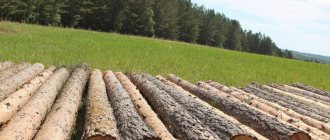The forestry industry is the largest manufacturing industry, consisting of several key areas. Enterprises and factories are located mainly near resources - forests. Natural potential exists in many countries, but in a number of regions human activity and irrational use of reserves have led to a significant depletion of forest wealth. Today, the topic of forest conservation is actively discussed in the world. The main task is to preserve trees, they are the lungs of the planet and clean the air. The forestry industry sector is considered one of the oldest industries in the world. It consists of main four branches:
- Paper and pulp production.
- Procurement of raw materials - wood is prepared for further processing.
- Wood processing.
- Timber chemical industry.
general characteristics
A quarter of the world's timber reserves are located on the territory of the Russian Federation. Forests occupy about 45% of the state's area. The main share of forest-forming species is formed from conifers: spruce, pine, larch and cedar.
The country's forest fund is divided into three main groups:
- Field-protective, water-protective, protected and recreational forests. In such areas, logging is carried out only for sanitary reasons.
- Territories where deforestation is carried out selectively and does not exceed the volume of annual growth.
- Operational areas in which clear cutting of commercial timber is carried out.
World development trends
Depending on the places of concentration of forests on our planet, the following zones are distinguished:
- Northern. This is the territory of taiga forests on the Eurasian and North American continents, where coniferous timber is harvested. A number of developed countries of the Eurasian and North American continents (USA, Russia, Finland, Canada, Sweden) specialize in the supply of wood raw materials on an international scale.
- Southern. Hardwood timber is harvested in three main regions of the globe - the forests of Brazil, tropical Africa and southeast Asia. Huge reserves of wood raw materials are concentrated on the South American continent, from where it is exported to Europe and Japan for further processing, or used as fuel for heating homes. In countries located in the southern hemisphere, alternative raw materials (not wood) are widely used for the production of paper products: bamboo branches are processed in India, sisal in Brazil and Tanzania, jute in Bangladesh, and sugar cane pulp in Peru.
The uneven distribution of forest resources, which are classified as renewable, poses the threat of their excessive use, which can lead to total deforestation of territories. For example, uncontrolled deforestation of equatorial rainforests has already led to large-scale environmental problems in Brazil and Mexico.
The developing countries of Asia, Africa and South America are increasing the procurement of wood raw materials every year, and China and India have already appeared among the traditional developed countries (USA, Canada, Finland, etc.), which were previously among the top ten procurement countries , Brazil and Indonesia, Nigeria and Congo. However, in developed countries, the percentage of industrial (high-quality) wood exceeds the share of firewood (used for fuel) several times, and in the countries of Latin America and Asia this picture is completely opposite. In the USA, Sweden, Finland, Canada, etc. In the structure of fuel consumption, firewood takes up from 3 to 12%, while in African countries - up to 78%, in China - up to 65%, in South America, about 57% of all harvested wood raw materials is used for firewood.
Structure
The timber industry complex (LPC) has a rather complex structure. All its branches can be divided into four large groups:
- Logging industry. Responsible for timber harvesting.
- Woodworking industry. Engaged in processing (mechanical and chemical-mechanical) wood and its processing. Enterprises in this group make furniture, harvest lumber, and so on.
- Pulp and paper industry. It involves mainly chemical processing of wood. Enterprises of this group produce paper, cardboard, cellulose and other products.
- Timber chemical industry. This includes the production of products such as coal, rosin, turpentine, etc.
Woodworking industry of the Russian Federation
This industrial branch performs mechanical, chemical and mechanical processing of wood.
It includes several productions:
- sawmill (creation of sleepers and lumber);
- production of houses from wood;
- production of wooden parts for construction;
- production of wood-based boards (blocks for doors and windows, parquet boards, wood fiber boards, wood chip boards, carpentry products);
- production of containers from wood;
- production of plywood, including parts that are glued and bent, as well as veneer;
- making matches;
- furniture manufacturing;
- production of other wood products (wood flour, skis, frames for greenhouses).
Economics of the forest industry
The industries that are part of the Russian timber industry occupy 7th place in terms of production volumes and 5th place in terms of product export volumes. The largest timber industry complexes in Russia are located in the following regions: the European North, Eastern and Western Siberia and the Far East. Here it is second only to metallurgy and the fuel industry.
Currently, the main product of the industry is commercial timber - its share among the total volumes of exported forest products ranges from 75 to 80%. Logging is considered the basic direction of the entire timber industry complex of Russia. At the end of the 80s of the last century, the Soviet Union in the world ranking was second only to America in terms of timber export volumes. After a series of economic transformations in recent decades, Russia has moved to 6th-7th place on this list.
As in other industries of the Russian Federation, based on the extraction and subsequent renewal of raw materials, in forestry, the main revenue is generated from the sale of raw materials for export. In this case, it is round timber (so-called round timber). For a long period, Russia was considered the main supplier of these raw materials to China, Japan, the countries of the Middle East and Europe.
In July 2007, the Russian government decided to increase the customs duty on roundwood exports by 20%. In April of the following year, this figure increased by another 25%. According to analysts from Lesprom Network, this government decision led to a significant decrease in the competitiveness of large timber industry complexes in the Russian Federation that rely on exports.
Impact of the global crisis
At the end of 2008, due to the global economic crisis, construction volumes in Western Europe, China and Japan fell sharply. Along with them, the volume of output of the timber industry in industries that consume wood has decreased. In 2008, the volume of timber harvesting in the Russian Federation was reduced by 14.4% compared to the previous year. At the same time, even a small increase was observed in wood processing and pulp and paper production: 1.4 and 0.8%, respectively.
The net profit ratio of Russian timber industry enterprises in 2008 also fell sharply, which is confirmed by the annual rating of the Forest Industry magazine. According to the publication, the total revenue of the companies included in the top 50 amounted to just over 216 billion rubles. 70% of this amount came from the top ten rankings. The share of enterprises specializing exclusively in wood processing amounted to 27% of total revenue.
Technological process
The first thing that specialists do after choosing a site for logging is felling trees. Next stages:
- trimming the crown and branches;
- removing bark from the trunk;
- skidding (transportation to the loading dock), sawing or bucking (transverse division of trunks) of wood;
- measuring and sorting.
The final stage is stacking, loading and transportation.
Note: almost the entire process is mechanized.
Specifics of the development of the timber industry complex
In addition to geographical features, there are general specifics of the industry’s development. Recently, there has been a decrease in the share of timber and paper products and an increase in the share of substitute goods. For example, the active introduction of plastic packaging has reduced the volume of paper packaging, and the development of the Internet has affected the consumption of newsprint.
There is no private ownership of forest lands in Russia. It is being replaced by long-term leases for logging and recreational purposes. However, there are a number of countries where it is quite possible to obtain private ownership of land. For example, in America, forest land management is a big business, with a turnover of up to $500 billion. The forest area there occupies about 0.5 billion acres. Of these, 53% are owned by private owners (not industrialists), 30% are publicly owned, 4% are owned by industrialists, and the remaining 8% are owned by financial investors.
The largest companies in the logging industry of the Russian Federation for 2017 (revenue is indicated in brackets) are:
- Ilim Group (112 billion rubles).
- "Mondi SYPC" (55 billion rubles).
- "GK Segezha" (43 billion rubles).
- International Paper (42 billion rubles).
- Sveza (31 billion rubles).
Let's get acquainted with the structure of the timber industry complex of the Russian Federation, considering its main sectors.
Lumber production
Russian-made lumber is in great demand on the world market. The main reason for this is the high quality of the products. Lumber from Siberia and the North-Western region, which has high strength during processing and a dense structure, is especially valued. Small and large timber industry complexes in the Russian Federation had to take advantage of this trump card when the government imposed large duties on the export of round timber. Thus, from the beginning of 2010, the volume of supplies of softwood lumber abroad began to grow. The main sales are in China, Uzbekistan, Egypt, Iran and Japan.
Among the federal districts, the largest volume of production occurs in Siberia, which produces up to 40% of the total volume in the country. In second place is the Northwestern District (28.4%), and in third place is the Volga District (11%). The established distribution of shares in the total production volume reflects the geographical location of timber processing enterprises.
Logging
Timber harvesting amounts to more than 200 million m3 annually. Approximately 81% of all timber is harvested by tenants of forest plots, where the target plots are 78. About 5.8 thousand legal entities and individual entrepreneurs carry out logging on a lease basis, 1.4 thousand of which are located in the Volga Federal District. Less than 500 are located in the Far Eastern region. The Russian Federation ranks 6th among the world's countries in timber harvesting. Enterprises are located based on the raw material factor.
The following tenants operate in this segment:
- 26 very large, annually harvest more than 500 m3 and occupy 20% of the market;
- 261 large ones with annual procurement of 100 – 500 m3, 32% on the market;
- 1264 average, annual volume of wood, which is 20 - 100 thousand m3, market share - 32%;
- 4197 small ones, they harvest less than 20 thousand m3 and occupy 17% of the market.
Most large enterprises operate in the Northwestern Federal District and Siberian Federal District. In recent years, the growth of large and very large companies in this sub-industry has been planned.
The main markets are in Finland and China, as well as:
- Near East;
- Japan;
- European countries.
Pulp and paper industry
As statistical data show, the pulp and paper industry is the largest (in terms of value) branch of the timber industry complex of the Russian Federation. Gradually, large industrial and financial associations were formed in this industry, which control the bulk of production.
In 2016, there was industry growth for all major products:
- Wood cellulose – by 4.2%.
- Paper – by 2.3%.
- Cardboard – by 3.3%.
But the production of non-corrugated cardboard boxes was reduced almost by half.
As the name suggests, the main product of this industry is cellulose. Its production capacity is estimated at 9.5 million tons. On average, their annual occupancy is 62%. The largest volumes of cellulose are produced in the following cities: Bratsk, Ust-Ilimsk, Arkhangelsk and Kotlas. They account for up to 90% of the country's output.
Paper and cardboard production capacity is estimated at approximately 9 million tons. At the same time, in per capita terms, Russia produces only 33 kilograms of paper per year. It seems that this is quite a lot, but there are countries in which this figure reaches more than 300 kg. One of the problems in this sector is the narrow range of products. The largest paper production enterprises are located in the following cities: Balakhna, Syktyvkar, Solikamsk, Svetogorsk, Segezha and Kotlas. As for cardboard, it is most produced in Arkhangelsk, Syktyvkar, Bratsk, Naberezhnye Chelny and St. Petersburg.
Enterprises related to the logging industry
- Ind Timber LLC;
- Rimbunan Hijau MDF LLC;
- LLC "Priangarsky Timber Processing Complex";
- OJSC Terneyles;
- GBU SO "Samarales";
- Russian Forest Alliance LLC;
- OJSC "Lakhdenpokhsky Timber Industry Enterprise";
- LLC Industrial and commercial enterprise "Titan";
- LLC "Group of Companies ULK";
- LLC "Lesprom-yug"
Other companies operating in this industry are presented in the Woodworking Plants section.
Plywood production
This material is widely used in furniture manufacturing, construction, and transport engineering. More than 50% of products produced in Russia are exported. In 2016, the volume of plywood production in the Russian Federation amounted to 3.65 million m3. Of these, 2.55 million were sold abroad.
The industry is actively updating equipment. The main production resources are concentrated in the mixed forest zone and in the south of the taiga. The largest manufacturers were also located there. The leaders in plywood production are the Komi Republic and the Kostroma region. Large production facilities are also located in: Irkutsk, Novgorod, Vologda, Leningrad regions and Perm region.
As statistics show, from 2010 to 2016. plywood production volumes increased 2.5 times. Production is divided approximately equally between three groups of enterprises: second-tier factories, small manufacturers. In terms of plywood export volumes, the Russian Federation remains firmly in fourth place, behind only China, Indonesia and Malaysia.
Main stages
The logging industry includes several main processes:
- Site preparation.
- Forest slashing. At the same time, work is being carried out on the preparation of stump resin, as well as on the extraction of resin.
- Timber rafting. There are departure (along small rivers) and transit - along large water bodies, including reservoirs. This stage includes the initial rolling of the product onto the water, the production of rafts and the raft itself.
- Timber handling works. Moving a product from one mode of transport to another.
Timber rafting
In addition, the industry also includes production for the use of low-value wood and waste:
- production of technological chips and container boards;
- sleeper sawing.
This also includes sawmilling, which provides primary mechanical processing of wood.
Match production
The production of matches from aspen is a traditional sub-industry for the Russian Federation. Almost all companies, with some exceptions, are located in the European part of the country. The largest producer is located in the Kaluga region. Smaller enterprises are located in the Bryansk, Novgorod, Yaroslavl, Penza, Kirov, Sverdlovsk, Tomsk regions, as well as in the Altai Territory and Bashkiria.
Recently, match production volumes have begun to decline sharply. If in 2006 8 million conventional boxes were produced in the Russian Federation, then by 2014 this figure had decreased to 2.4 million. The main reasons for this trend are: outdated equipment, low profitability, and, of course, the growing market for lighters.
Furniture industry
In the 1980s, the furniture industry of the Soviet Union was characterized by a large share of manual labor, insufficiently qualified employees and high wear and tear of equipment. As a result, in terms of volume, quality and technological parameters, manufactured products did not always meet consumer demands. Another problem was that the country did not produce special equipment for furniture factories.
With the introduction of economic reforms in the 1990s, the situation changed. A large selection of products, materials, components and technologies has been formed. And even the furniture industry successfully overcame the crisis of the late 1990s without losing highly qualified personnel and production potential.
In the period from 2000 to 2008. The furniture market was actively developing. Every year, product sales increased by an average of 23%, taking into account price changes. If in 2009-2010 there was a significant decline in production due to the crisis, then in 2011-2012 the volume of furniture production exceeded even the pre-crisis level. At the same time, the country's accession to the WTO led to an increase in the share of cheap imports. As a result, the main competitive advantages of Russian furniture (low cost of materials and low labor costs) have lost their strength.
Since 2014, when, due to the rise of the dollar, foreign suppliers became uncompetitive, everything has returned to its place. In 2016, the share of domestic producers in the domestic market amounted to more than 80% in volume and up to 63% in value terms. As for the export of furniture from the Russian Federation, it has remained at a low level since the beginning of the new century, significantly inferior to exports. In 2015, the Russian Federation's share in global furniture production was less than 1%. In comparison, the share of America is 27%, Japan, Germany and Italy – 9%, and China – 7%.
About 5-6 thousand enterprises produce wooden furniture in Russia. Of these, only fifteen have annual turnover exceeding 1 billion rubles. These enterprises account for approximately half of production. About five hundred companies have a turnover of 0.3-1 billion rubles and are classified as medium-sized businesses.
The furniture industry is the only segment of the timber industry whose centers are remote from the main areas of raw material extraction. The lion's share of enterprises is concentrated in the Central (Moscow, Yaroslavl and Ryazan regions), Northwestern, Volga and Southern districts. They occupy 86% of the furniture market. The leader is the Central District, which accounts for almost half of all production. Thus, a paradoxical phenomenon is observed in the furniture industry of the Russian Federation - the main production facilities are located in non-forested areas, which is not typical for the timber industry complex. Thus, in the Far East and Siberia, where the largest woodworking companies are located, there are no large furniture production centers yet.
Pellet production
This industry is new and rapidly developing for Russia. Pellets, being an environmentally friendly fuel, are otherwise exported to European countries. The main producers are concentrated in the Krasnoyarsk Territory, Arkhangelsk, Tver, Vologda regions and Karelia. Thanks to an unlimited raw material base, the industry has great opportunities for growth. So far, in comparison with the world market, pellet production volumes in Russia are insignificant. According to various sources, they range from 0.9 to 1.5 million tons, which, even with the most positive assessment, does not reach the level of Latvia.
The development of the biofuel sector in the Russian Federation is regulated by a number of government programs for the coming decades. However, according to experts from the Forest Industry magazine, the intended goals are not clear enough. According to government programs, by 2020, 4.5% of electricity in Russia should be produced using alternative sources. For example, in Norway this figure reaches 67%, in Sweden – 50%, and in Latvia – 40%.
With the increase in biofuel consumption in Central European countries, the latter will begin to experience a shortage of forest resources, so they will rely on the import of pellets. Russia has every opportunity to occupy a large part of this market, but to do this it needs to improve relations with Europe. The main competitors of the Russian Federation in this field are Canada, America and Brazil, which have large reserves of biofuel raw materials.











